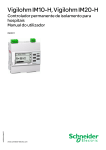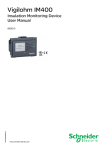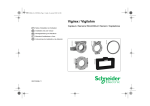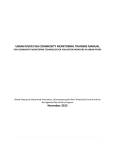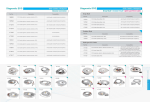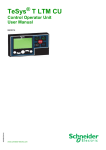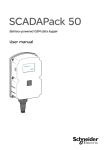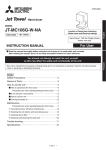Download Vigilohm IM10-H, Vigilohm IM20-H - Insulation Monitoring Device for
Transcript
Vigilohm IM10-H, Vigilohm IM20-H VIGED310023EN 09/2011 Vigilohm IM10-H, Vigilohm IM20-H Insulation Monitoring Device for Hospitals User Manual VIGED310023EN 09/2011 www.schneider-electric.com The information provided in this documentation contains general descriptions and/or technical characteristics of the performance of the products contained herein. This documentation is not intended as a substitute for and is not to be used for determining suitability or reliability of these products for specific user applications. It is the duty of any such user or integrator to perform the appropriate and complete risk analysis, evaluation and testing of the products with respect to the relevant specific application or use thereof. Neither Schneider Electric nor any of its affiliates or subsidiaries shall be responsible or liable for misuse of the information contained herein. If you have any suggestions for improvements or amendments or have found errors in this publication, please notify us. No part of this document may be reproduced in any form or by any means, electronic or mechanical, including photocopying, without express written permission of Schneider Electric. All pertinent state, regional, and local safety regulations must be observed when installing and using this product. For reasons of safety and to help ensure compliance with documented system data, only the manufacturer should perform repairs to components. When devices are used for applications with technical safety requirements, the relevant instructions must be followed. Failure to use Schneider Electric software or approved software with our hardware products may result in injury, harm, or improper operating results. Failure to observe this information can result in injury or equipment damage. © 2011 Schneider Electric. All rights reserved. 2 VIGED310023EN 09/2011 Table of Contents Safety Information . . . . . . . . . . . . . . . . . . . . . . . . . . . . . . . . . . . . . . . . . . . . About the Book . . . . . . . . . . . . . . . . . . . . . . . . . . . . . . . . . . . . . . . . . . . . . . . Chapter 1 Presentation . . . . . . . . . . . . . . . . . . . . . . . . . . . . . . . . . . . . . . . . . . . . . . . . . 5 7 9 Presentation . . . . . . . . . . . . . . . . . . . . . . . . . . . . . . . . . . . . . . . . . . . . . . . . . . . . . . . . . . . . . . . Physical Description . . . . . . . . . . . . . . . . . . . . . . . . . . . . . . . . . . . . . . . . . . . . . . . . . . . . . . . . . Vigilohm HRP Accessory . . . . . . . . . . . . . . . . . . . . . . . . . . . . . . . . . . . . . . . . . . . . . . . . . . . . . 10 12 13 Chapter 2 Installation. . . . . . . . . . . . . . . . . . . . . . . . . . . . . . . . . . . . . . . . . . . . . . . . . . . 15 Safety Measures . . . . . . . . . . . . . . . . . . . . . . . . . . . . . . . . . . . . . . . . . . . . . . . . . . . . . . . . . . . . Dimensions . . . . . . . . . . . . . . . . . . . . . . . . . . . . . . . . . . . . . . . . . . . . . . . . . . . . . . . . . . . . . . . . Flush-mounting and Dismantling. . . . . . . . . . . . . . . . . . . . . . . . . . . . . . . . . . . . . . . . . . . . . . . . DIN Rail Mounting and Dismantling . . . . . . . . . . . . . . . . . . . . . . . . . . . . . . . . . . . . . . . . . . . . . Connection . . . . . . . . . . . . . . . . . . . . . . . . . . . . . . . . . . . . . . . . . . . . . . . . . . . . . . . . . . . . . . . . Typical Applications. . . . . . . . . . . . . . . . . . . . . . . . . . . . . . . . . . . . . . . . . . . . . . . . . . . . . . . . . . 16 17 18 20 21 22 Chapter 3 Functions. . . . . . . . . . . . . . . . . . . . . . . . . . . . . . . . . . . . . . . . . . . . . . . . . . . . 25 Monitoring the System Insulation . . . . . . . . . . . . . . . . . . . . . . . . . . . . . . . . . . . . . . . . . . . . . . . Transformer Monitoring . . . . . . . . . . . . . . . . . . . . . . . . . . . . . . . . . . . . . . . . . . . . . . . . . . . . . . . Self-test . . . . . . . . . . . . . . . . . . . . . . . . . . . . . . . . . . . . . . . . . . . . . . . . . . . . . . . . . . . . . . . . . . . 26 28 29 Chapter 4 Human Machine Interface . . . . . . . . . . . . . . . . . . . . . . . . . . . . . . . . . . . . . . 31 Vigilohm IM10-H Menu Structure . . . . . . . . . . . . . . . . . . . . . . . . . . . . . . . . . . . . . . . . . . . . . . . Vigilohm IM20-H Menu Structure . . . . . . . . . . . . . . . . . . . . . . . . . . . . . . . . . . . . . . . . . . . . . . . Navigating the Interface . . . . . . . . . . . . . . . . . . . . . . . . . . . . . . . . . . . . . . . . . . . . . . . . . . . . . . Status Screens . . . . . . . . . . . . . . . . . . . . . . . . . . . . . . . . . . . . . . . . . . . . . . . . . . . . . . . . . . . . . Modifying Parameters . . . . . . . . . . . . . . . . . . . . . . . . . . . . . . . . . . . . . . . . . . . . . . . . . . . . . . . . Clock (Vigilohm IM20-H) . . . . . . . . . . . . . . . . . . . . . . . . . . . . . . . . . . . . . . . . . . . . . . . . . . . . . . Insulation Fault Log (Vigilohm IM20-H) . . . . . . . . . . . . . . . . . . . . . . . . . . . . . . . . . . . . . . . . . . . 32 33 34 36 37 38 39 Chapter 5 Communication via Modbus RS-485 (Vigilohm IM20-H) . . . . . . . . . . . . . . 41 Configuration of the RS-485 Communication Port . . . . . . . . . . . . . . . . . . . . . . . . . . . . . . . . . . Table of Modbus Functions . . . . . . . . . . . . . . . . . . . . . . . . . . . . . . . . . . . . . . . . . . . . . . . . . . . . Modbus Registers Table . . . . . . . . . . . . . . . . . . . . . . . . . . . . . . . . . . . . . . . . . . . . . . . . . . . . . . 42 43 44 Chapter 6 Maintenance and Troubleshooting . . . . . . . . . . . . . . . . . . . . . . . . . . . . . . . 49 Maintenance and Troubleshooting . . . . . . . . . . . . . . . . . . . . . . . . . . . . . . . . . . . . . . . . . . . . . . 49 Chapter 7 Specifications . . . . . . . . . . . . . . . . . . . . . . . . . . . . . . . . . . . . . . . . . . . . . . . . 51 Specifications . . . . . . . . . . . . . . . . . . . . . . . . . . . . . . . . . . . . . . . . . . . . . . . . . . . . . . . . . . . . . . 51 VIGED310023EN 09/2011 3 4 VIGED310023EN 09/2011 Safety Information § Important Information NOTICE Read these instructions carefully, and look at the equipment to become familiar with the device before trying to install, operate, or maintain it. The following special messages may appear throughout this documentation or on the equipment to warn of potential hazards or to call attention to information that clarifies or simplifies a procedure. PLEASE NOTE Electrical equipment should be installed, operated, serviced, and maintained only by qualified personnel. No responsibility is assumed by Schneider Electric for any consequences arising out of the use of this material. A qualified person is one who has skills and knowledge related to the construction and operation of electrical equipment and its installation, and has received safety training to recognize and avoid the hazards involved. VIGED310023EN 09/2011 5 6 VIGED310023EN 09/2011 About the Book At a Glance Document Scope This manual is intended for use by designers, system builders, and maintenance technicians who are concerned with ungrounded electrical distribution systems (IT) featuring insulation monitoring devices (IMDs) for medical applications. Validity Note To ensure maximum patient safety, operating rooms call for continuous availability and impeccable quality in terms of electrical power. Consequently, the relevant standards lay down highly stringent rules. At certain medical facilities, use of the IT system is mandatory. The Vigilohm IM10-H and IM20-H insulation monitoring devices are the key components within this subsystem. Related Documents Title of Documentation Reference Number Instruction Sheet: Vigilohm IM10-H Insulation Monitoring Device S1A40440 Instruction Sheet: Vigilohm IM20-H Insulation Monitoring Device S1A40442 Secure power distribution and monitoring solution for operating theatres - Solution guide DESWED109024EN Solution de distribution électrique sécurisée et de surveillance pour blocs opératoires Guide de la solution DESWED109024FR You can download these technical publications and other technical information from our website at www.schneider-electric.com. User Comments We welcome your comments about this document. You can reach us by e-mail at [email protected]. VIGED310023EN 09/2011 7 8 VIGED310023EN 09/2011 Vigilohm IM10-H, Vigilohm IM20-H Vigilohm IM10-H, IM20-H - Presentation VIGED310023EN 09/2011 Presentation 1 What’s in this Chapter? This chapter contains the following topics: Topic VIGED310023EN 09/2011 Page Presentation 10 Physical Description 12 Vigilohm HRP Accessory 13 9 Vigilohm IM10-H, IM20-H - Presentation Presentation Use the IT System to Improve the Availability of Power Systems Continuity of service is an essential operational requirement for power systems, as is ensuring the protection of people and property. There are many applications which vary from country to country. The "ungrounded" IT system is the best option for ensuring continuity of service. Even after an initial insulation fault has occurred, the installation can continue to function without posing any danger to people or equipment. However, the faulty circuit must be detected and repaired before a second fault occurs. The fact that the IT system can tolerate an initial fault means that maintenance operations can be improved and carried out safely and without any pressure. The IT System at Medical Facilities At Group 2 medical facilities, the medical IT system must be used for the supply circuits. These include those for the electrical medical equipment as well as for the life support systems and systems intended for surgical applications, on the one hand, and the other equipment in the patient environment, on the other. It is practically impossible to draw up a list of Group 2 facilities because the method for categorizing how facilities are used can vary from one country to another and may even differ within the same country. The list of examples below has been provided purely for information: Anaesthetizing room Operating room Pre-operating room Surgical dressings (plaster) room Post-op recovery room Cardiac catheterization room Intensive care room Angiographic examination room Premature babies room Monitor Insulation Resistance (R) Standards IEC 364, IEC 61557-8, and IEC 60364-7-710 stipulate that the installation must be ungrounded when the IT system is used. In the event of only one ground or earth fault, the fault current is very low and interruption is unnecessary. However, given that a second fault could potentially cause the circuit breaker to trip, an insulation monitoring device has to be installed to indicate an initial fault. This device must trigger an audible and/or a visual signal. By constantly monitoring the insulation resistance, you can keep track of the system quality, which is a form of preventive maintenance. Function of Vigilohm IM10-H and IM20-H Devices The Vigilohm IM10-H and IM20-H are digital insulation monitoring devices (IMDs) for low-voltage systems with isolated neutral IT. Assigned to specific IT islands in hospitals, they can be used to monitor the insulation of a system and signal any insulation faults as soon as they occur. The Vigilohm IM10-H and IM20-H apply a low-frequency AC voltage between the system and ground. The insulation is then assessed on the basis of the current value returned. The Vigilohm IM10-H and IM20-H offer the following functions: Insulation resistance display (R) Detection of insulation faults in accordance with a configurable threshold Detection of a lost connection (ground or injection) The Vigilohm IM20-H offers the following additional functions: Communication via the Modbus RS-485 protocol Insulation fault log Transformer monitoring: Display of load current for secondary (as a percentage) Threshold-based triggering of an alarm (as a percentage of nominal current) Temperature alarm (bimetal contact) 10 VIGED310023EN 09/2011 Vigilohm IM10-H, IM20-H - Presentation Selection Guide VIGED310023EN 09/2011 Function Vigilohm IM10-H Vigilohm IM20-H Measurement and display of IT system insulation resistance √ √ Threshold-based triggering of alarm √ √ Display of transformer load current — √ Transformer overload alarm — √ Transformer high temperature alarm — √ Time-tagged log (insulation faults, overloads, and transformer overheating events) — √ Communication via Modbus RS-485 — √ Remote compatibility in operating room (Vigilohm HRP) √ √ 11 Vigilohm IM10-H, IM20-H - Presentation Physical Description Physical Description The Vigilohm IM10-H and IM20-H feature 3 and 6 terminal blocks respectively (identifiers A to F). The various features of the Vigilohm are shown in the diagram below: A B G H I ON L Alarm Menu J Esc K M N C D E F A B C D Injection terminal block Vigilohm auxiliary power supply terminal block Alarm relay terminal block Terminal block for 1 A or 5 A CT input for measuring the secondary current of the insulation transformer (Vigilohm IM20-H) E Modbus communication terminal block (Vigilohm IM20-H) F Terminal block for the bimetal input for monitoring the temperature of the insulation transformer (Vigilohm IM20-H) G Contextual menu buttons H Operating LED I Alarm LED J Menu button for accessing main menu K Button for returning to previous menu or canceling a parameter entry L Display M Vigilohm serial number N Vigilohm product catalog number (IMD-IM10-H or IMD-IM20-H) 12 VIGED310023EN 09/2011 Vigilohm IM10-H, IM20-H - Presentation Vigilohm HRP Accessory Presentation The Vigilohm HRP (Hospital Remote Panel) (catalog number 50168) remote accessory for operating rooms serves as a user interface for the systems that are used to monitor electrical installations in hospitals. Installed in the operating block, the Vigilohm HRP lets hospital staff know, in real time, whether the installation is operating correctly or whether there is a fault: Insulation fault affecting the electrical equipment of the operating block Electrical fault following tripping of a protective circuit breaker or overloading of a current transformer Physical Description 1 2 3 4 5 Number Description 1 Orange LED: Visual signal indicating an insulation fault 2 Green LED: Indicates that the installation is operating correctly 3 Red LED: Visual signal indicating an electrical fault (transformer overloaded or overheating or circuit breaker fault trip) 4 Pushbutton for testing the insulation monitoring system (daily test in accordance with standard IEC 60364-7-710) 5 Pushbutton for stopping the audible alarm in the event of an insulation fault or electrical fault. The sound level is set during installation (setting accessible on rear panel). Mounting The Vigilohm HRP is flush-mounted on a partition. Connection The Vigilohm HRP is connected to the alarm relay terminal block (see page 21). VIGED310023EN 09/2011 13 Vigilohm IM10-H, IM20-H - Presentation Characteristics Characteristics Value Mechanical Characteristics Weight Case 0.5 kg Plastic Degree of protection Vertical mounting IP54 IK08 Dimensions Audible alarm Height 170 mm Width 170 mm Depth 20 mm Factory setting 80 db (adjustable) 24 Vdc 65 mA Electrical Characteristics Auxiliary supply voltage Environment 0...40 °C Operating temperature Storage temperature -25...+70 °C Maximum relative humidity 90% Altitude 2000 m Standards Compliant with IEC 60364-7-710 Medical facilities IEC 61557-8 Electrical safety IEC 60601-1 Electrical medical equipment NOTE: The Vigilohm HRP is subject to testing on Anios products (disinfectants, antiseptics, or detergents). 14 VIGED310023EN 09/2011 Vigilohm IM10-H, Vigilohm IM20-H Vigilohm IM10-H, IM20-H - Installation VIGED310023EN 09/2011 Installation 2 What’s in this Chapter? This chapter contains the following topics: Topic VIGED310023EN 09/2011 Page Safety Measures 16 Dimensions 17 Flush-mounting and Dismantling 18 DIN Rail Mounting and Dismantling 20 Connection 21 Typical Applications 22 15 Vigilohm IM10-H, IM20-H - Installation Safety Measures Specific Hazard Associated with Insulation Monitoring Devices (IMDs) In the case of almost all electric and electronic devices, the device’s power supply is the root cause of electrical hazards. The hazard can be eliminated by disconnecting the power supply. This is not the case with insulation monitoring devices, which are connected to the system via the injection wire. Consequently, this connection must be broken before carrying out any kind of work on the product. DANGER RISK OF ELECTRIC SHOCK, EXPLOSION, OR ARC FLASH Before carrying out work of any kind, disconnect the Vigilohm from the monitored system by disconnecting the injection wire at terminal 1. Disconnect all the power supplies running to the Vigilohm and the equipment on which it is installed. Always use a correctly calibrated voltage tester to check that the injection wire and power supply have been properly disconnected. Failure to follow these instructions will result in death or serious injury. Other Safety Measures Carefully read through the safety measures described below. You are always required to implement them fully before attempting to install, repair, or service electrical equipment. DANGER RISK OF ELECTRIC SHOCK, EXPLOSION, OR ARC FLASH Wear suitable personal protective equipment and follow the currently applicable electrical safety instructions. This equipment may only be installed by qualified electricians who have read all the relevant information. NEVER work alone. Before performing visual inspections, tests, or maintenance on this equipment, disconnect all sources of electric power. Assume that all circuits are live until they have been completely deenergized, tested and tagged. Pay particular attention to the design of the power system. Consider all power supply sources, particularly the potential for backfeed. Before closing protective covers and doors, carefully inspect the work area to ensure that no tools or objects have been left inside the equipment. Take care when removing or replacing panels. Take special care to ensure that they do not come into contact with live busbars. To minimize the risk of injuries, do not tamper with the panels. The successful operation of this equipment depends upon proper handling, installation, and operation. Failure to follow basic installation procedures can lead to personal injury as well as damage to electrical equipment or other property. NEVER shunt an external fuse/circuit breaker. The Vigilohm must be installed in a suitable electrical cabinet. Failure to follow these instructions will result in death or serious injury. 16 VIGED310023EN 09/2011 Vigilohm IM10-H, IM20-H - Installation Dimensions Vigilohm Dimensions mm 96 45 96 110 93.7 92.4 ±0.4 46.3 59 92.4 ±0.4 CAUTION CUTTING HAZARD Trim the edges of the cut-out plates to remove any jagged edges. Failure to follow these instructions can result in injury or equipment damage. Constraints for Flush-mounting Observe the correct distances between devices. VIGED310023EN 09/2011 17 Vigilohm IM10-H, IM20-H - Installation Flush-mounting and Dismantling Presentation The Vigilohm can be attached to any flat, rigid vertical support using the 3 spring clips supplied. The device must not be tilted following installation. To free up useful space for control gear, you can attach the Vigilohm to the front panel of the floorstanding or wall-mounted enclosure. Installation on a Support Before attaching the Vigilohm, check the following: The mounting plate must have a thickness of between 0.8 and 3.2 mm. A square measuring 92 x 92 mm must be cut out from the plate so the device can be installed. No terminal blocks may be connected to the unit. To install the Vigilohm, proceed as follows: Step Action 1 Insert the Vigilohm in the cut-out in the mounting plate by tilting the device forward slightly. 1 2 Depending on the thickness of the mounting plate, clip the 3 spring clips into the fixing slots on the device as follows: Mounting Plate Thickness Fixing Slots to Be Used 0.8 mm ≤ X ≤ 2 mm 3 2 5 5 X 4 4 2 mm < X ≤ 3.2 mm 3 2 5 5 X 3 18 4 4 Wire up and insert the terminal blocks as shown in the relevant wiring diagram (see page 21) and as appropriate for the type of device concerned (Vigilohm IM10-H or IM20-H) (see page 12). VIGED310023EN 09/2011 Vigilohm IM10-H, IM20-H - Installation Removal from a Mounting Plate To remove the Vigilohm from a mounting plate, proceed as follows: Step Action 1 Disconnect the terminal blocks from the Vigilohm. 2 Deal with each of the 3 spring clips as follows: Insert the blade of a screwdriver between the spring clip and the device. Then use the screwdriver as a lever to release the spring clip. 2 1 3 VIGED310023EN 09/2011 Reinsert the terminal blocks, making sure that the correct positions on the device (Vigilohm IM10-H or IM20-H) (see page 12) are observed. 19 Vigilohm IM10-H, IM20-H - Installation DIN Rail Mounting and Dismantling Presentation You can install the Vigilohm on a DIN rail. The device must not be tilted following installation. When mounting the device on, or dismantling it from, a DIN rail, you can keep the terminal blocks connected and/or wired up, or you can remove them and keep them to hand. DIN Rail Mounting To install the Vigilohm on a DIN rail, proceed as follows: Step Action 1 Position the 2 upper slots on the rear of the Vigilohm on the DIN rail. 2 Press the device against the DIN rail until the locking mechanism engages. The device is now attached to the rail. 1 Click! 2 Removal from a DIN rail To remove the Vigilohm from a DIN rail, proceed as follows: Step 20 Action 1 Using a flat screwdriver (≤ 6.5 mm), lower the locking mechanism to release the device. 2 Lift the device up to free it from the DIN rail. VIGED310023EN 09/2011 Vigilohm IM10-H, IM20-H - Installation Connection Connection Diagram Terminals 9 to 16 are not available on the Vigilohm IM10-H. L U = 110-230 Va N IT transformer, bi-metal strip contact, min. y 24 Vc 5 mA 6A 6A 1 3 4 5 Shorting block 6 7 8 9 10 11 12 13 14 15 16 0V Relay setting: Failsafe (recommended) IM10-H/ IM20-H Relay setting: standard 6 7 8 Vigilohm HRP D0 = A’ / Rx-, A / TxD1 = B’ / Rx+, B / Tx+ IM10-H/ IM20-H Modbus RS 485 6 7 8 Vigilohm HRP The alarm relay is connected in the same way with a programmable logic controller (PLC) as part of the advanced solution for an operating block. Connection Characteristics All the terminals of the Vigilohm IM10-H and IM20-H have identical characteristics. The table below shows the characteristics of the cables that can be used to connect the terminals: VIGED310023EN 09/2011 Stripped Length Cable c.s.a. Tightening Torque Type of Screwdriver 7 mm 0.2...2.5 mm² 0.8 N•m Flat, 3 mm 21 Vigilohm IM10-H, IM20-H - Installation Typical Applications Presentation The following section presents 2 insulation monitoring applications for an operating room: One with a Vigilohm IM10-H and a Vigilohm HRP One with a Vigilohm IM20-H where the alarm is sent to a supervisor Architecture with Vigilohm IM10-H and Vigilohm HRP By virtue of the fact that there is a Vigilohm HRP present in the operating room, this monitoring system can be used to collate and display all the information relating to the alarms generated by the electrical installation. IMD Cabinet Electrical fault Vigilohm HRP Insulation fault Operating room Vigilohm HRP Connection Principle: Operating room IM10-H 1 wire - electrical fault (circuit breaker fault trip or transformer overload) Vigilohm HRP 2 wires (NC contact) 2 wires (N, ground) 2 wires (+24 V 0 V) ABL8MEM24003 Existing or special power supply For example: ABL8MEM24003 A slightly different version of this architecture is also possible, whereby a Vigilohm IM20-H is connected to a supervisor outside the operating room via Modbus. 22 VIGED310023EN 09/2011 Vigilohm IM10-H, IM20-H - Installation Architecture with Vigilohm IM20-H and supervisor By using Modbus communication, the operating room staff or maintenance staff can be provided with: The insulation value The load level of the transformer The alarms Time tagging of events This ensures the traceability of all events. Electrical fault Sensors Insulation fault Magelis HRP Electrical fault Insulation fault Operating room 1 Sensors Magelis HRP Operating room 2 Principle involved in connecting to a supervisor: IM20-H Magelis HRP 2 wires (NC contact) 4 wires (Modbus) VIGED310023EN 09/2011 PLC Modbus TCP/IP 23 Vigilohm IM10-H, IM20-H - Installation 24 VIGED310023EN 09/2011 Vigilohm IM10-H, Vigilohm IM20-H Vigilohm IM10-H, IM20-H - Functions VIGED310023EN 09/2011 Functions 3 What’s in this Chapter? This chapter contains the following topics: Topic VIGED310023EN 09/2011 Page Monitoring the System Insulation 26 Transformer Monitoring 28 Self-test 29 25 Vigilohm IM10-H, IM20-H - Functions Monitoring the System Insulation Functional Description The Vigilohm monitors the IT system insulation in kΩ in accordance with the following timing diagram: 1 2 3 Insulation Alarm ON Failsafe OFF Alarm relay ON activation Standard OFF Alarm LED ON OFF INSULATION Display R = 8 M7 10k 100k 1M 10M INSULATION ALARM INSULATION FAULT R = 40 k7 R = 8 M7 R = 40 k7 T 10k 100k 1M 10M T 10k 100k 1M 10M T 1 An insulation fault is detected on the system, the Vigilohm switches to the alarm status. The alarm relay changes over and the alarm LED lights up. 2 The user acknowledges the alarm by pressing the button. The alarm relay reverts to its initial status. 3 The insulation fault is corrected. The alarm LED goes out. The Vigilohm reverts to normal status. When the Vigilohm is in the alarm status and the user fails to acknowledge the alarm, the insulation fault is transient. Status Information The display and the 2 two-color LEDs on the Vigilohm indicate the device’s current status. LEDs ON Description Alarm Vigilohm de-energized Vigilohm energized, no insulation fault detected flashes slowly Vigilohm energized, insulation fault detected flashes slowly Vigilohm energized, transient insulation fault detected flashes slowly flashes Vigilohm energized but malfunctioning Alarm Threshold Setting range: 50...500 kΩ Default value: 50 kΩ When the device is powered up, it reverts to the most recent alarm threshold value saved. 26 VIGED310023EN 09/2011 Vigilohm IM10-H, IM20-H - Functions Alarm Relay Depending on the status of the insulation, the alarm relay is, or is not, activated according to the mode selected: failsafe (by default) or standard. The failsafe alarm relay is activated in the following cases: An insulation fault is detected. The product has failed. The product is not being supplied with power. VIGED310023EN 09/2011 27 Vigilohm IM10-H, IM20-H - Functions Transformer Monitoring Presentation The IT system can be used to ensure optimum availability. All or part of the system can potentially still be lost in the event of a transformer overload or short circuit. The impact of a short circuit is limited by discrimination. Overload The relevant standard stipulates that overloads and increases in temperature must be monitored in relation to IT system transformers. With the Vigilohm IM10-H, this monitoring function is performed independently of insulation monitoring. In the case of the Vigilohm IM20-H, the function is integrated to facilitate operation and implementation. To avoid global tripping as a result of an overload, the transformer load current is measured continuously, displayed as a load percentage and compared with an alarm threshold. Due to the fact that high temperature is the result of prolonged overload, temperature monitoring is less critical and the incorporation of a bimetal temperature sensor is perfectly sufficient. A transformer fault constitutes a critical installation fault (which is not true of an insulation fault): On the Vigilohm IM20-H, transformer faults take priority over an insulation fault. On the Vigilohm HRP, the red LED for indicating an electrical fault lights up in the event of a transformer fault. On the Magelis panel (advanced solution for operating room), the load is displayed in the form of a bar graph and a dedicated alarm. Integration with an Existing Supervision Solution All the transformer data (alarms, current, thresholds) is available via Modbus communication. 28 VIGED310023EN 09/2011 Vigilohm IM10-H, IM20-H - Functions Self-test Description The Vigilohm has a self-test function for testing: The product: LEDs, internal electronics The measurement system and the alarm relay Running the Self-test The test can be run/runs: Manually at any time by pressing the T contextual menu button on one of the system insulation monitoring screens Automatically: Whenever the device starts up (power-up or reset) Every 5 hours (except when the device is in the alarm status, regardless of whether the alarm is active, has been acknowledged, or is transient). Sequence of LEDs During the verification sequence, the LEDs light up in the following order: Alarm white ON red Alarm yellow ON green Self-test OK If the self-test is successful, the following screen appears for 3 seconds: After that, one of the status screens appears automatically (system insulation resistance measurement, insulation fault alarm, or IT transformer fault alarm). Self-test Not OK If the self-test fails, the Alarm LED turns red and a message is displayed to indicate that the product is malfunctioning. If this happens, briefly disconnect the auxiliary power supply of the Vigilohm. If the fault persists, contact technical support. VIGED310023EN 09/2011 29 Vigilohm IM10-H, IM20-H - Functions 30 VIGED310023EN 09/2011 Vigilohm IM10-H, Vigilohm IM20-H Vigilohm IM10-H, IM20-H - Human Machine Interface VIGED310023EN 09/2011 Human Machine Interface 4 Presentation The Vigilohm features a sophisticated and intuitive human machine interface (HMI) with signaling LEDs, a graphic display, and contextual menu buttons for accessing the information required to operate the Vigilohm and make parameter settings. What’s in this Chapter? This chapter contains the following topics: Topic VIGED310023EN 09/2011 Page Vigilohm IM10-H Menu Structure 32 Vigilohm IM20-H Menu Structure 33 Navigating the Interface 34 Status Screens 36 Modifying Parameters 37 Clock (Vigilohm IM20-H) 38 Insulation Fault Log (Vigilohm IM20-H) 39 31 Vigilohm IM10-H, IM20-H - Human Machine Interface Vigilohm IM10-H Menu Structure Vigilohm IM10-H Menu Structure 32 VIGED310023EN 09/2011 Vigilohm IM10-H, IM20-H - Human Machine Interface Vigilohm IM20-H Menu Structure Vigilohm IM20-H Menu Structure VIGED310023EN 09/2011 33 Vigilohm IM10-H, IM20-H - Human Machine Interface Navigating the Interface Presentation The diagram below illustrates the various elements for operating the Vigilohm. 1 2 3 Menu Esc 1 2 3 Screen identification area containing a menu icon, and the name of the menu or parameter Information area for displaying screen-specific details (measurement, alarm, setting) Navigation buttons Navigation Buttons The navigation buttons enable quick and intuitive navigation: 3 Menu 1 Esc 2 4 5 Legend Button Icon Description 1 Menu — Displays the level 1 menu (Menu) 2 Esc — Takes you back to the previous level 3 Contextual menu button 3 For scrolling up the display or moving to the previous item in a list For accessing the date and time setting If the clock icon flashes, it means that the Date/Time parameter needs to be set. For increasing a numerical value 4 Contextual menu button 2 For scrolling down the display or moving to the next item in a list For moving one digit to the left within a numerical value. If the digit on the far left is already selected, pressing the button loops you back to the digit on the right. For moving one digit to the right within a numerical value 5 Contextual menu button 1 OK T For confirming the selected item For executing the manual test For accessing a menu or sub-menu, or for editing a parameter For acknowledging alarms 34 VIGED310023EN 09/2011 Vigilohm IM10-H, IM20-H - Human Machine Interface Information Icons The following table describes the icons provided for information in the information area of the LCD display. Among other things, they indicate which menu is selected or the alarm status. Icon Description Main menu Identifies the system resistance when there is no insulation fault Measurement parameters menu Fault log menu (Vigilohm IM20-H) Setting parameters menu Interface language selection menu i Product identification Indicates an insulation fault alarm VIGED310023EN 09/2011 35 Vigilohm IM10-H, IM20-H - Human Machine Interface Status Screens Presentation The default screen is the one that shows the system’s insulation resistance value. This is automatically replaced by a screen for indicating an insulation fault or a transformer fault (where applicable). The alarm screens flash. System Insulation Resistance Measurement (R) The Vigilohm displays the insulation resistance measurement for the system by default. Alarm Detected: Insulation Fault Message The following screen is displayed when the insulation value drops below the alarm threshold: Press the contextual menu button to acknowledge the alarm. Alarm Acknowledged The following screen appears once the alarm is acknowledged: Transformer Alarm Message The following screen appears in the event of the IT transformer becoming overloaded or overheating: Press the OK contextual menu button to exit the screen. The alarm screen for the transformer affected by the fault now appears. 36 Example for transformer overload: Example for overheating of transformer: VIGED310023EN 09/2011 Vigilohm IM10-H, IM20-H - Human Machine Interface Modifying Parameters Presentation To modify any of the values, you must be thoroughly familiar with how the interface menus are structured and the general navigation principles. For more information about how the menus are structured, please refer to the section that relates specifically to your Vigilohm model: IM10-H (see page 32) IM20-H (see page 33) To modify the value of a parameter, follow either of the 2 methods described below: Select an item (value plus unit) in a list. Modify a numerical value, digit by digit. The parameters listed below are the only ones where the numerical value can be modified: Date Time Password Modbus address (Vigilohm IM20-H) Selecting the Value in a List To select a value in a list: Use the or contextual menu buttons to scroll through the parameter values until you reach the desired value; then press OK to confirm the new parameter value. Modifying the Numerical Value The numerical value of a parameter is made up of digits and it is the one on the far right that is selected by default. To modify a numerical value, use the contextual menu buttons as described below: allows you to modify the selected digit. allows you to select the digit to the left of the one that is currently selected, or to loop back to the digit on the right. OK confirms the new parameter value. Saving a Parameter After you have confirmed the modified parameter, one of 2 things will happen: If the parameter has been saved correctly, the screen displays Saved and then automatically reverts to the previous display. If the parameter has not been saved correctly, the screen displays Out Of Range and the editing screen remains active. A value is deemed to be out of range when it is classed as forbidden or when there are several interdependent parameters, for example. Aborting an Entry To abort the current parameter entry, press the Esc button. The screen reverts to the previous display. VIGED310023EN 09/2011 37 Vigilohm IM10-H, IM20-H - Human Machine Interface Clock (Vigilohm IM20-H) Description The time must be set: Whenever the power supply is interrupted When switching from winter to summer time If the auxiliary power supply is interrupted, the Vigilohm IM20-H retains the date and time setting from immediately before the interruption. The Vigilohm IM20-H uses the date and time parameter to time-tag the system insulation faults and the transformer alarms recorded. Icon When the Vigilohm IM20-H is powered up, the clock icon flashes on the system monitoring screens to indicate that the clock needs to be set. Setting To set the date and time, please refer to the procedure for modifying a numerical value (see page 37). Date/Time Format The date is displayed in the format: dd/mm/yyyy. The time is displayed using the 24-hour clock in the format: hh/mm. 38 VIGED310023EN 09/2011 Vigilohm IM10-H, IM20-H - Human Machine Interface Insulation Fault Log (Vigilohm IM20-H) Description The Vigilohm IM20-H records the last 30 events from the following categories: Alarm Transformer overload Overheating of transformer Event 1 is the one that was recorded most recently and event 30 is the oldest recorded event. The oldest event is deleted when a new event occurs (the table is not reset). By referring to this information, the performance of the distribution system can be improved and maintenance work facilitated. Fault Event Screen The diagrams below show the display elements associated with each type of fault event: VIGED310023EN 09/2011 Legend Description 1 Insulation value or load percentage at the time of the fault’s occurrence 2 Type of fault recorded: Insulation fault, overload, or overheating of transformer 3 Date and time of the fault’s occurrence 4 Date and time when the event disappeared: Alarm acknowledgment Disappearance of alarm Disappearance of transformer alarm 5 Number of event displayed 6 Total number of events recorded 39 Vigilohm IM10-H, IM20-H - Human Machine Interface 40 VIGED310023EN 09/2011 Vigilohm IM10-H, Vigilohm IM20-H Vigilohm IM10-H, IM20-H - Communication VIGED310023EN 09/2011 Communication via Modbus RS-485 (Vigilohm IM20-H) 5 What’s in this Chapter? This chapter contains the following topics: Topic VIGED310023EN 09/2011 Page Configuration of the RS-485 Communication Port 42 Table of Modbus Functions 43 Modbus Registers Table 44 41 Vigilohm IM10-H, IM20-H - Communication Configuration of the RS-485 Communication Port Communication Parameters Before initiating any communication processes, configure the Modbus communication port via the HMI (Settings → Modbus menu) on the Vigilohm IM20-H: Parameters Authorized Values Default Value Baud rate 19 200 Baud Parity Even Odd None Even Address 1...247 1 4800 Baud 9600 Baud 19 200 Baud 38 400 Baud Signaling of Communication Activity On the Modbus parameter setting screen, the green ON LED indicates the status of communication between the Vigilohm IM20-H and the master as follows: 42 If... Then... The LED is flashing Communication with the device has been correctly established The LED is on permanently There is no active communication between the master and slave VIGED310023EN 09/2011 Vigilohm IM10-H, IM20-H - Communication Table of Modbus Functions Modbus Functions Function Code Function Name Decimal Hexadecimal 3 0x03 Read Holding Registers(1) 4 0x04 Read Input Registers(1) 6 0x06 Write Single Register 8 0x08 Diagnostics 16 0x10 Write Multiple Registers 67 / 14 0x43 / 14 Read Device Identification 67 / 15 0x43 / 15 Get Date/Time 67 / 16 0x43 / 16 Set Date/Timee (1) The Read Holding and Read Input registers are identical VIGED310023EN 09/2011 43 Vigilohm IM10-H, IM20-H - Communication Modbus Registers Table Table Format Register tables have the following columns: Modbus Register Address dec RW Unit Type Range Description hex Modbus Register Address: Address of register encoded in the Modbus frame, in decimal (dec) and hexadecimal (hex) formats RW: Whether the register is read only (R) or read-write (RW) Unit: The unit the information is expressed in Type: The encoding data type Range: The permitted values for this variable, usually a subset of what the format allows Description: Provides information about the register and the values that apply System Status Modbus Register Address RW Unit Type Range Description dec hex 102...103 65...66 R — Uint16 Encoded version X.Y.Z Firmware version X.Y.Z: X represents the primary revision number, which is encoded in the most significant byte of register 102. Y represents the secondary revision number, which is encoded in the least significant byte of register 102. Z represents the quality revision number, which is encoded in register 103. 105 69 RW — Uint16 0...99 — Year (from 2000 to 2099) in least significant byte Most significant byte reserved 106 6A RW — Uint16 1...12 1...31 Month in most significant byte Day in least significant byte 107 6B RW — Uint16 1...23 0...59 Time in most significant byte Minutes in least significant 108 6C RW ms Uint16 0...59999 Milliseconds 109 6D R — Uint16 — Most significant byte = Error byte code Least significant byte = Product status 0x00 - Normal operation 0x01 - Self-test 0x02 - Insulation fault and/or transformer fault 0x03 - Wiring connection lost 0x04 - Over limit capacitance 0x05 - Product malfunctioning 44 VIGED310023EN 09/2011 Vigilohm IM10-H, IM20-H - Communication Monitoring Modbus Register Address RW Unit Type Range Description 3E8 R Ohm Float32 — Resistance. The value NaN (Not a Number) 0xFFC00000 is returned during the self-test. 1006 3EE R % Uint32 — Transformer load current. The value NaN (Not a Number) 0xFFC00000 is returned during the self-test. 1008 3F0 R — Uint16 0 = Correct RW Unit Type Range Description R — Uint16 0 = No alarm 1 = Alarm Alarm dec hex 1000 I/O wiring: Overheating of transformer temperature 1 = Temperature too high Alarm Status Modbus Register Address dec hex 1100 44C active 8 = Alarm acknowledged 1101 44D R — Uint16 0 = No alarm 1 = Overload Transformer alarm alarm 2 = Overheating alarm 3 = Overload and overheating alarms active Settings Modbus Register Address dec hex 3001 BB9 RW Unit Type Range Description RW — Uint16 1 = Standard Alarm relay logic command. Default value: 2 (Failsafe). connection 2 = Failsafe VIGED310023EN 09/2011 3002 BBA RW Ohm Uint32 50...500 kΩ Alarm threshold. Default value: 50 kΩ. 3010 BC2 RW A Uint16 1A 5A Transformer CT, secondary. Default value: 5 A. 3011 BC3 RW A Uint16 40...250 Transformer CT, primary. Default value: 50 A. 3012 BC4 RW % Uint16 1...100 Transformer overload threshold. Default value: 80%. 3013 BC5 RW A Uint16 12...250 Transformer nominal current. Default value: 36 A. 3014 BC6 RW — Uint16 0000...9999 Password. Default value: 0000. 3015 BC7 RW — Uint16 0 = Deactivated Password protection. 1 = Activated Default value: 0 (Deactivated). 45 Vigilohm IM10-H, IM20-H - Communication Modbus Register Address dec hex 3016 BC8 RW Unit Type Range Description RW — Uint16 0 = English 1 = Français Interface language. Default value: 0 (English). 2= 3= 4 = Español 5 = Italiano 6 = Deutsch 7 = Português 3017 BC9 RW % Uint16 0...100 Display contrast. Default value: 50. 3018 BCA RW % Uint16 10...100 Display brightness. Default value: 100. Log Modbus Register Address dec hex 4000 FA0 RW Unit Type Range Description R — Uint16 1...60 Number of event records 4001 FA1 R — Uint16 — Number of most recent record 4002-4013 FA2-FAD R — Record — Record 1 4014-4025 FAE-FB9 R — Record — Record 2 1266-1271 R — Record — Record 60 ... 4710-4721 Each event is stored using 2 records: A "primary" record, which is created when the alarm occurs. This contains the insulation value, transformer load, or status of the transformer temperature sensor. A "secondary" record, which is created when the alarm disappears. This contains the type of event (acknowledged alarm, disappearance of overload or overheating event). The 2 records are not consecutive (for example, scenario in which a transformer alarm occurs during an insulation fault). 46 VIGED310023EN 09/2011 Vigilohm IM10-H, IM20-H - Communication Description of an Event Record in the Log Register Unit Type Range Description Word 1 — Uint16 1…65535 Event record number Word 2 Word 3 Word 4 Word 5 — Uint64 — Time tagging of event (using the same code as for the product date/time) Word 6 Word 7 — Uint32 0...1 0x40, 0x10 1000, 1006, 1008, 1100, 1101 Word 8 Word 9 Word 10 Word 11 — Uint64 — Record identifier: Word 6, most significant byte: Information for primary/secondary record. This field assumes a value of 1 for the primary record and a value of 0 for the secondary record. Word 6, least significant byte: Type of data stored in the Value field Word 7: Address of the Modbus register that is the source of the data in the Value field Depending on the type of record (primary or secondary): Primary record (when the event occurs): Insulation resistance value (in ohms) (encoded in Float32 in the last 2 registers) Transformer load (as a % of the nominal load encoded in Uint32 in the last 2 registers) Status of bimetal strip (encoded in Uint16 in the last register) Secondary record (when the event disappears or is acknowledged): Alarm type (encoded in Uint16 in the last register) Word 12 VIGED310023EN 09/2011 — Uint16 1...65534 Primary/secondary record identifier for event: In the case of a primary record for an event, this identifier is an odd integer; numbering starts at 1 and the number is incremented by 2 for each new event. In the case of a secondary record for an event, this identifier is equal to the primary record identifier plus 1. 47 Vigilohm IM10-H, IM20-H - Communication Example of an Event The 2 records below represent an alarm that occurred at 12:00 on October 1, 2010 and was acknowledged at 12:29. Record number: 1 Modbus Register Address dec Unit Type Value Description hex 4002 FA2 — Uint16 1 4003 FA3 — Uint64 Record number 4007 FA7 — Uint32 1 0x40 1000 10 0 10 1 12 0 0 Date when alarm occurred (October 1, 2010, 12:00) Record identifier: Primary record plus secondary record Float32 value (insulation resistance) Value of register 1000 (register for insulation resistance monitoring) 4009 FA9 Ohm Uint64 10000 Insulation resistance value at the time of the alarm 4013 FAD — Uint16 1 Secondary record identifier for event Unit Type Value Description Record number Record number: 2 Modbus Register Address dec hex 4014 FAE — Uint16 2 4015 FAF — Uint64 4019 FB3 — Uint32 1 0x10 1100 10 0 10 1 12 29 0 Date when alarm disappeared (October 1, 2010, 12:29) Record identifier: Secondary record Uint16 value (alarm acknowledged) Value of register 1100 (alarm status register) 48 4021 FB5 — Uint64 8 Value of alarm register at the time of alarm acknowledgment 4025 FB9 — Uint16 2 Secondary record identifier for event VIGED310023EN 09/2011 Vigilohm IM10-H, Vigilohm IM20-H Vigilohm IM10-H, IM20-H - Maintenance and Troubleshooting VIGED310023EN 09/2011 Maintenance and Troubleshooting 6 Maintenance and Troubleshooting Safety Precautions The following safety precautions must be thoroughly implemented before attempting to repair electrical equipment or carry out maintenance. Carefully read and follow the safety precautions described below. DANGER RISK OF ELECTRIC SHOCK, ARC FLASH OR BURNS Wear suitable personal protective equipment and follow the currently applicable electrical safety instructions. See, for example, standard NFPA 70E when carrying out work in the USA. Only qualified personnel should maintain this equipment. Such work should be performed only after reading all the installation instructions. Turn off all power supplying this equipment before working on or inside it. NEVER work alone. Beware of potential hazards and wear personal protective equipment. Failure to follow these instructions will result in death or serious injury. NOTICE RISK OF DAMAGE TO VIGILOHM Never open the Vigilohm unit. Do not attempt to repair any components in the Vigilohm range, either in the unit or an accessory. Failure to follow these instructions can result in equipment damage. ON LED The red ON LED indicates an error relating to one of the following: Interruption of the injection circuit Self-test not OK Device fault Interruption of the Injection Circuit If the injection circuit of the Vigilohm is interrupted, the display shows the message below and starts flashing: Self-test The Vigilohm performs a series of self-tests on start-up, and then at regular intervals during operation, in order to detect any potential faults in its internal and external circuits. For more information on the selftest function, please refer to the relevant section (see page 29). VIGED310023EN 09/2011 49 Vigilohm IM10-H, IM20-H - Maintenance and Troubleshooting Troubleshooting The table below describes the potential problems and their probable causes. It also indicates the checks that can be carried out or provides possible solutions for each scenario. If you are still unable to resolve a problem after consulting the table, please contact your Schneider Electric regional sales representative for assistance. 50 Potential Problem Probable Cause Possible Solution The device displays nothing when switched on. The device is not being supplied. Check the auxiliary power supply is present. The auxiliary power supply does not comply. Check the value of the auxiliary voltage: U = 90...265 Vac. The device signals an insulation fault, but your system shows no signs of abnormal behavior. The fault alarm threshold is not appropriate. Check the value of the alarm threshold. Modify the alarm threshold if necessary. You deliberately create an insulation fault, but the device fails to detect it. The resistance value used to simulate the fault is greater than the value of the fault threshold. Use a resistance value that is lower than the alarm threshold or modify the alarm threshold. The fault is not detected between neutral and ground. Start again ensuring you are between neutral and ground. The ON LED is red and the display shows "WIRING CONNECTION LOST". The Vigilohm injection circuit is cut off. Check the connection on the injection terminal block (terminals 1 and 3) and restart the self-test. The ON LED is red and the display indicates that an error occurred during the self-test. The Vigilohm injection circuit is cut off. Briefly disconnect the auxiliary power supply for the Vigilohm. Faulty LED. Although the Vigilohm is being supplied with power, the ON LED does not light up. Restart the self-test and check that the ON LED lights up briefly. The Alarm LED does not light up Faulty LED. in the event of a fault. Restart the self-test and check that the Alarm LED lights up briefly. VIGED310023EN 09/2011 Vigilohm IM10-H, Vigilohm IM20-H Vigilohm IM10-H, IM20-H - Specifications VIGED310023EN 09/2011 Specifications 7 Specifications Type of System to Be Monitored Characteristic LV AC/DC IT systems Value Phase-to-phase voltage range 0-230 Vac (+ 15%) Frequency 50/60 Hz Electrical Characteristics Characteristic Value Range for insulation resistance readings 1 kΩ...10 MΩ Fault signaling Number of thresholds 1 (password protected) Thresholds 50...500 kΩ Response time ≤1s Maximum system capacitance 5 μF Device performance test Self-test and manual test Internal impedance At 50 Hz Accuracy Output contact 110 kΩ 5% Number 1 (standard or failsafe)(1) Type of contact Changeover Breaking capacity 250 Vac 6A Capacity 12...24 Vdc 6A Input contact Voltage supplied 24 V Bimetal transformer Minimum load Auxiliary supply voltage 50/60 Hz Cable dimensions 5 mA 110-230 Vac (± 15%) 0.2...2.5 mm² Maximum device consumption 12 VA Measurement voltage 25 V max. Measurement current 0.9 mA Dielectric strength 4000 Vac/5500 Vdc (1) Failsafe: The relay is deactivated either on occurrence of a fault or if the auxiliary supply voltage accidentally fails. Mechanical Characteristics Characteristic Value Weight Thermoplastic case VIGED310023EN 09/2011 0.25 kg Mounting Panel or DIN rail Degree of protection Front IP52 Installation Inside, category III, pollution 2, in molded case, disconnectable unit, symmetrical or flush-mounted 51 Vigilohm IM10-H, IM20-H - Specifications Other Characteristics Characteristic Value Temperature range Climatic conditions For operation —25...+55 °C For storage —40...+70 °C IEC 60068 (1) Standards Product IEC 61557-8 (Appendix A, Appendix B) Safety IEC 61010-1 (2) Installation IEC 60364-7-710 (1) Suitable for use in all climates: Damp heat, equipment not operating (IEC 60068-2-30) Damp heat, equipment operating (IEC 60068-2-56) Salt mist (IEC 60068-2-52) (2) U ≤ 300 V L-N nominal 52 VIGED310023EN 09/2011 VIGED310023EN Schneider Electric Industries SAS 35, rue Joseph Monier CS30323 F - 92506 Rueil Malmaison Cedex www.schneider-electric.com As standards, specifications and designs change from time to time, please ask for confirmation of the information given in this publication. 09/2011
























































